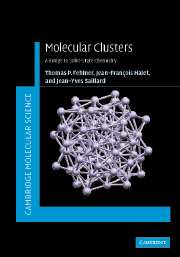Book contents
- Frontmatter
- Contents
- Preface
- 1 Introduction
- 2 Main-group clusters: geometric and electronic structure
- 3 Transition-metal clusters: geometric and electronic structure
- 4 Isolobal relationships between main-group and transition-metal fragments. Connections to organometallic chemistry
- 5 Main-group–transition-metal clusters
- 6 Transition to the solid state
- 7 From molecules to extended solids
- 8 Inter-conversion of clusters and solid-state materials
- Appendix: Fundamental concepts: a concise review
- Problem Answers
- References
- Index
- References
2 - Main-group clusters: geometric and electronic structure
Published online by Cambridge University Press: 19 February 2010
- Frontmatter
- Contents
- Preface
- 1 Introduction
- 2 Main-group clusters: geometric and electronic structure
- 3 Transition-metal clusters: geometric and electronic structure
- 4 Isolobal relationships between main-group and transition-metal fragments. Connections to organometallic chemistry
- 5 Main-group–transition-metal clusters
- 6 Transition to the solid state
- 7 From molecules to extended solids
- 8 Inter-conversion of clusters and solid-state materials
- Appendix: Fundamental concepts: a concise review
- Problem Answers
- References
- Index
- References
Summary
Clusters – a form of matter with structure and properties lying somewhere between those of atoms and solid-state substances – impact a substantial fraction of chemistry, drawing the attention of both inorganic and physical chemists. The larger the cluster the stronger the connection with solid-state chemistry and the greater the ramifications for modern materials science in the area of nanochemistry. The term cluster is used to designate a three-dimensional assembly of atoms and cluster structures may be found in s-, p-, and d-block element chemistries. When composed of a single element, the cluster motif complements the chains and rings of molecular catenates and the chains, sheets and networks of solid substances. Clusters are found with external ligands as well as without. Cluster structure is the focus of this text and we intend to show that cluster electronic structure serves as a bridge between molecular compounds and non-molecular solid-state compounds. These connections will become more readily apparent as the structural properties of clusters are developed.
The story begins in this chapter with the clusters of simplest geometric and electronic structure. These are clusters of p-block elements with defined stoichiometry and structure in which the cluster surface-atom valences are “terminated” with ligands. The large number known provide the factual base from which clever people have derived models that connect atomic composition with structure. In turn, these p-block models provide a foundation on which to build an understanding of more complex clusters such as condensed clusters, bare clusters and transition-metal clusters.
- Type
- Chapter
- Information
- Molecular ClustersA Bridge to Solid-State Chemistry, pp. 33 - 84Publisher: Cambridge University PressPrint publication year: 2007
References
- 1
- Cited by



